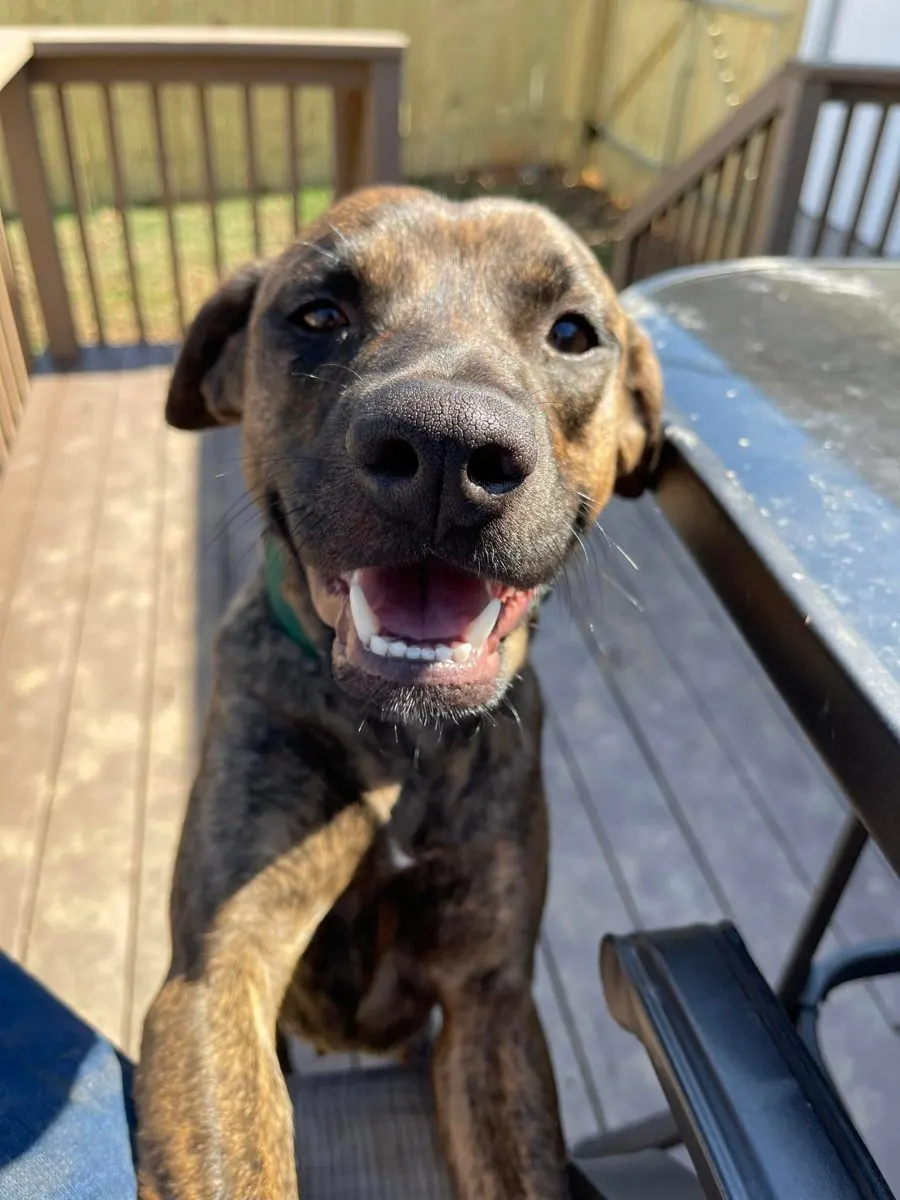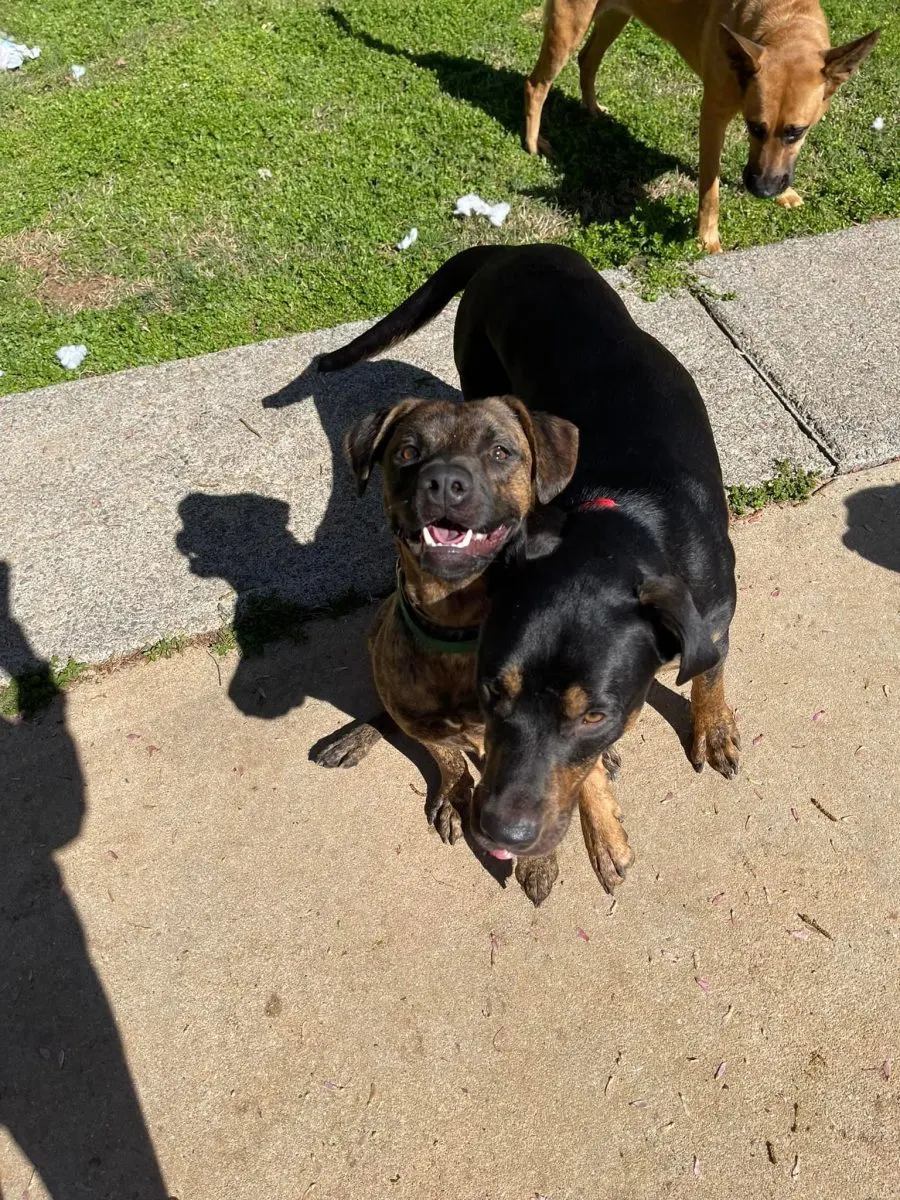It is dogs like Mulan that make us wonder – how many of these four-legged animals end their journey without having a chance to reveal their true selves?
This sweet girl had no other choice in life but to be way too protective, and so far, that only caused her trouble. Due to her traumatic past experience, Mulan was facing euthanization.
She was classified as a “severely reactive” dog that no one wanted. She barked at everybody and didn’t let anyone near her kennel, so the shelter staff decided to put her to eternal sleep.
But, then, at the very last minute, a giant-hearted dog lover stepped in and changed Mulan’s life for the better!
The Unexpected Breakthrough

Mulan’s owners surrendered her to a shelter, as their landlord required they get rid of the dog. When she entered the shelter, she was quite terrified.
She had never been socialized with other people and other dogs, so she felt the need to be overprotective all the time. She didn’t let anybody touch her or even get near her in the kennel, so she ended up on the euthanasia list.
Then, the long-awaited miracle happened!
One of the volunteers who worked at the shelter contacted Martha Moore, the vice president of Friends of Guilford County Animal Shelter, from North Carolina, to see if she could help the dog out.
Martha was more than happy to do it, especially after hearing that the dog hadn’t left the kennel for 13 days straight.
“She was so emotionally shut down and not letting anyone near her kennel. She had, by the end of the day, to leave the shelter or she would be put down,” her foster mom told The Dodo.
Martha, a giant-hearted volunteer, spent two hours getting to know Mulan in the shelter. The dog was very anxious and scared, but eventually, she let Martha put a leash on her and take her home.
For the first couple of days, Mulan was cautious, trying to adapt to her new foster home, but she was still way too destructive. One day, Mulan had completely destroyed the room, and she looked very terrified.

Instead of scolding her, Martha just sat down on the floor, completely ignored all the mess, and gave this poor girl a treat. That very moment was a breakthrough for the two!
For the first time ever, Mulan approached Martha and started giving her the sweetest kisses, as if she was trying to say: “Thank you for not punishing me!”
Transformation Of A Lifetime

Since that day, Mulan’s behaviour has improved significantly. She completely opened her heart to her foster family and her new North Carolina home.
It took this cutie pie only two weeks to transform into a brand-new dog. Even though she was still cautious around other people for the first few minutes, she socialized with others so much easier than she used to.
“Mulan is a sensitive girl and needs about 15 minutes to warm up to new people. Once you give her time to get comfortable, you’ll have a friend for life,” says Martha.
She even let her foster momma give her belly rubs and hug her, like she does with her other dogs.
“Mulan loves playing with other dogs, shares her toys and food/water bowls nicely, and even gets along with cats! The perfect package,” Martha wrote on her Facebook.

After two months of love, cuddles, intensive work, and socialization, she was a completely new girl, ready to embrace a new life!
She found the pawfect family that was ready to give her what she had been looking for all this time – love, understanding, and a lot of patience! With all this at her new home, I’m absolutely pawsitive that she’s gonna make her new hoomans so happy!
If you’ve noticed your furry friend’s eye looking a bit red, it can be concerning. As a seasoned dog enthusiast, you understand the importance of keeping a close eye on your pet’s health. A red eye in dogs can stem from various reasons, ranging from minor irritations to more serious underlying issues.
Your pup’s eyes are not just windows to their soul but also indicators of their well-being. Understanding what might be causing the redness can help you provide the necessary care and attention your canine companion deserves. So, let’s delve into the common reasons why your dog’s eye may be red and what steps you can take to ensure their ocular health is in top shape.
Understanding Canine Eye Redness
Causes of Red Eyes in Dogs
Dog’s eyes can turn red due to various reasons, such as allergies, infections, scratches, or foreign objects in the eye. Allergies from pollen or dust, for instance, can lead to redness. Similarly, infections like conjunctivitis or even glaucoma can cause red eyes in dogs.
Signs That Your Dog May Have an Eye Issue
Watch out for signs like squinting, tearing, discharge, or cloudiness in your dog’s eye. Excessive rubbing or pawing at the eye area can also indicate a problem. If you notice any of these signs, it’s essential to seek veterinary help promptly to address the issue.
Common Conditions Leading to Eye Redness
Conjunctivitis in Dogs
If your dog’s eye is red, it could be due to conjunctivitis, commonly known as pink eye in dogs. Conjunctivitis can be caused by allergies, infections, or irritants. Symptoms may include redness, discharge, and excessive blinking. Your vet can provide appropriate treatment, which may include eye drops or ointments.
Canine Glaucoma
Glaucoma can also lead to red eyes in dogs. It is a condition characterized by increased pressure within the eye, causing pain and redness. Other signs include a dilated pupil, cloudiness in the cornea, and vision changes. Immediate veterinary attention is crucial to manage glaucoma and prevent vision loss.
Allergies Affecting Dogs’ Eyes
Allergies are another common cause of eye redness in dogs. Pollen, dust, or certain foods can trigger allergic reactions that manifest as red, itchy eyes. Your vet may recommend antihistamines or other medications to alleviate symptoms and reduce eye redness caused by allergies.
Dry Eye Syndrome
Dry eye syndrome, or keratoconjunctivitis sicca, can result in red, irritated eyes in dogs. This condition occurs when the eyes do not produce enough tears to keep the surface moist. Signs of dry eye include redness, discharge, and frequent pawing at the eyes. Your vet may prescribe eye drops or ointments to manage dry eye and improve your dog’s comfort.
Remember to monitor your dog’s eye health closely and seek veterinary attention if you notice persistent redness, discharge, or any changes in behavior related to their eyes. Early detection and treatment of eye conditions can help prevent complications and ensure your furry friend’s visual comfort.
Diagnosing Red Eyes in Dogs
Veterinary Examination Procedures
When you bring your dog to the vet for red eyes, the first thing they’ll do is conduct a thorough examination. This typically involves checking your furry friend’s eyes for any signs of injury, infection, or inflammation. The vet may also perform tests to determine the underlying cause of the redness, such as checking for corneal scratches, measuring tear production, or assessing intraocular pressure.
What to Expect During Your Visit to the Vet
During your visit to the vet, you can expect a series of steps to diagnose your dog’s red eyes. The vet will start by asking you about your dog’s medical history and any symptoms you’ve noticed. They’ll then proceed to examine your dog’s eyes using specialized equipment to get a closer look at the structures of the eye. Based on their findings, the vet will recommend a treatment plan to address the specific cause of the redness and ensure your dog’s eye health.
Treatment Options for Red Eyes in Dogs
When it comes to treating red eyes in dogs, there are several options available to help alleviate the discomfort and address the underlying cause of the issue. Here are some common treatment approaches:
Medications and Eye Drops
One of the primary treatment options for red eyes in dogs involves the use of medications and eye drops prescribed by your veterinarian. These may include antibiotics to combat infections, anti-inflammatory drugs to reduce inflammation, or lubricating eye drops to help with dryness. It’s essential to follow your vet’s instructions carefully when administering these medications to ensure effectiveness and avoid any potential side effects.
Surgery and Special Procedures
In more severe cases of red eyes in dogs, surgery or special procedures may be necessary to address the underlying condition. Procedures such as eyelid surgery to correct abnormalities or remove obstructions, or laser therapy to treat certain eye conditions, may be recommended by your veterinarian. These interventions aim to improve your dog’s eye health and alleviate any discomfort or vision issues associated with red eyes.
Home Care and Management
In addition to medical interventions, there are steps you can take at home to help manage your dog’s red eyes. Keeping your dog’s eyes clean by gently wiping away any discharge or debris, ensuring a balanced diet rich in essential nutrients for eye health, and avoiding exposure to potential allergens or irritants can all contribute to maintaining healthy eyes. Regular check-ups with your vet can help monitor your dog’s eye condition and catch any issues early on.
Treating red eyes in dogs requires a combination of veterinary care, at-home management, and potentially specialized procedures to address the underlying cause effectively. By working closely with your veterinarian and following their recommendations, you can help ensure your furry friend’s eye health and overall well-being.
Prevention and Care at Home
Routine Eye Care for Dogs
Maintaining good eye health in your furry friend doesn’t have to be complicated. You can start by regularly inspecting your dog’s eyes for any signs of redness, discharge, or cloudiness. Use a clean, damp cloth to gently wipe away any debris around the eyes. Avoid using harsh chemicals or soaps near the eye area to prevent irritation.
When to Seek Veterinary Help
If you notice persistent redness in your dog’s eyes, accompanied by symptoms like excessive blinking, squinting, or pawing at the eyes, it’s time to schedule a visit to the vet. These indications could point to a more serious underlying issue that needs professional attention. Early intervention can help prevent any further complications and ensure your dog’s eye health is properly addressed.
Conclusion
So, when you notice your furry friend’s eye turning red, it’s essential to take action promptly. Redness in your dog’s eye could be a sign of various issues like allergies, infections, or irritants. Keep an eye out for symptoms like discharge, excessive blinking, dilated pupils, cloudiness, or changes in vision. Remember, quick veterinary attention is key to preventing any potential vision loss. Treatment options, including medications, eye drops, or even surgery, can help address the underlying causes. Don’t forget about good home care practices like keeping their eyes clean and avoiding allergens. Regular eye checks and immediate vet consultation for persistent redness or concerning symptoms are crucial for maintaining your dog’s eye health. Stay vigilant and proactive to ensure your furry companion’s eyes stay healthy and happy.
Frequently Asked Questions
What are the common causes of red eyes in dogs?
Red eyes in dogs can be caused by various conditions such as conjunctivitis, glaucoma, allergies, and dry eye syndrome. Symptoms may include discharge, excessive blinking, dilated pupils, cloudiness, and vision changes.
Why is it important to seek veterinary attention for red eyes in dogs?
It is crucial to seek veterinary attention promptly to prevent vision loss. Veterinarians can conduct thorough examinations to determine the underlying cause and provide appropriate treatment options like medications, eye drops, surgery, or special procedures.
How can I care for my dog’s eyes at home?
Home care practices include keeping the eyes clean, providing a balanced diet, and avoiding allergens. Regularly inspect your dog’s eyes for redness, discharge, or cloudiness, and gently wipe away debris with a clean, damp cloth.
When should I seek veterinary help for my dog’s red eyes?
If persistent redness is observed along with symptoms like excessive blinking, squinting, or pawing at the eyes, you should seek veterinary help promptly. This is essential to address any serious underlying issues and ensure proper care for your dog’s eye health.
[no_toc]

Hey there, I’m Janet Brooks, a dog-loving student from California. I’m all about helping pups in need, especially those without homes. Me and my awesome friends work together to give shelter and love to stray dogs. Oh, and I also write blogs about dogs to share helpful info.